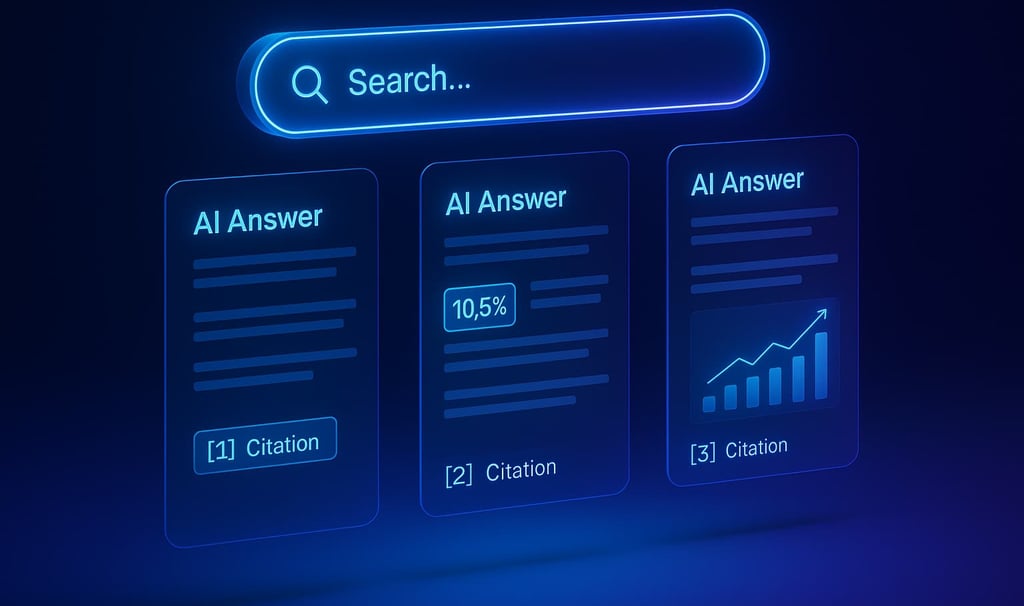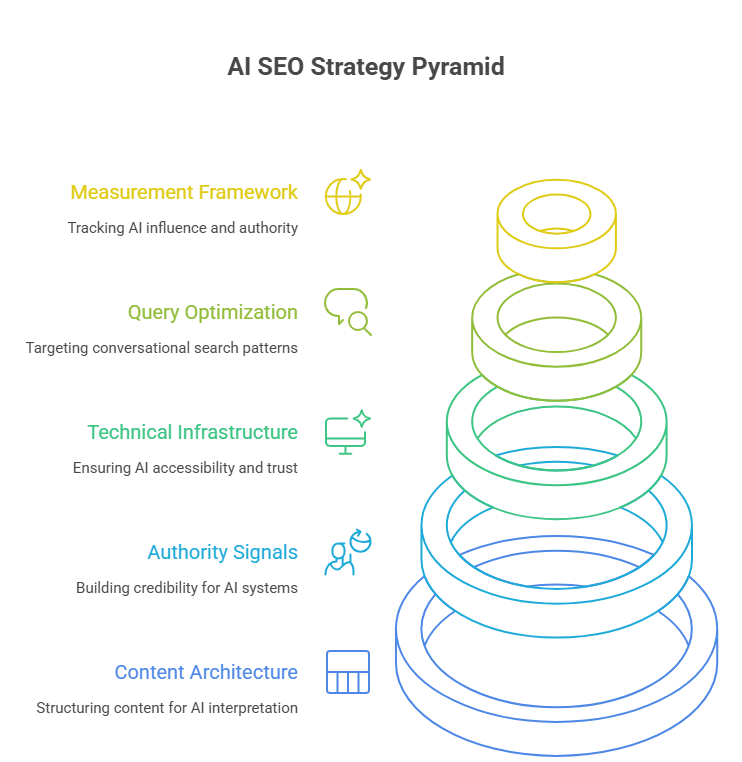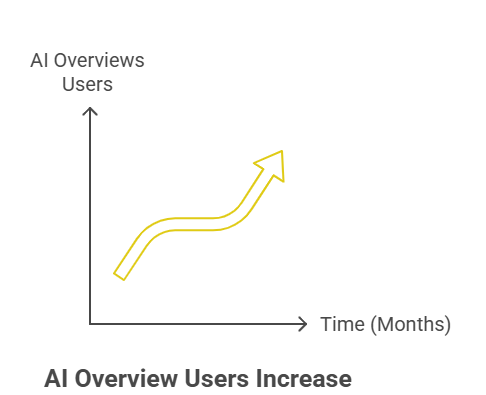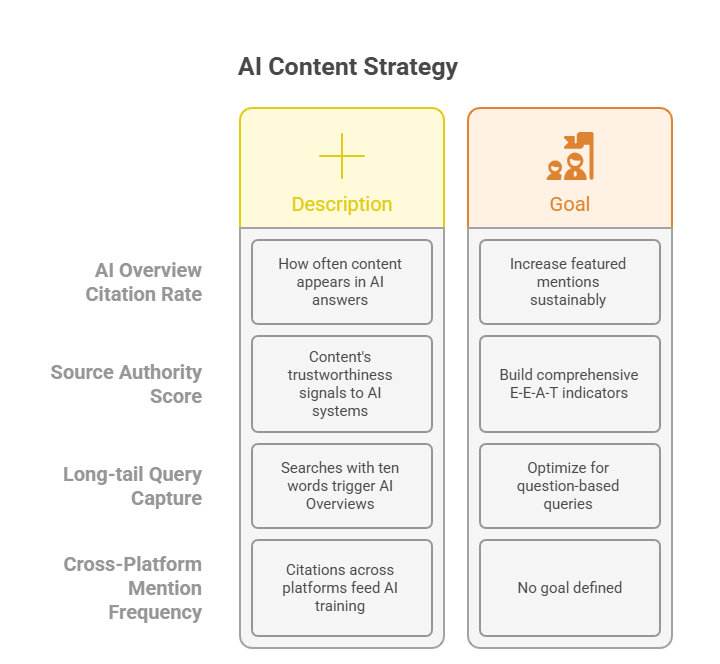AI SEO: The Ultimate Guide to Optimizing for AI-Powered Search
SAASAI_SEO
8/27/20257 min read


Key Takeaways: How to Optimize for AI-Powered Search
Define AI SEO Objectives: Focus on metrics like AI Overview citations and source authority, not just traditional rankings and organic traffic.
Structure Content for Extraction: Use answer-first formatting, clear headings (H1, H2), and self-contained paragraphs so AI can easily lift passages for its answers.
Establish Verifiable Authority: Publish proprietary data, display clear author credentials (E-E-A-T), and build a presence in communities that AI models use for training.
Optimize Technical Performance: Maintain excellent Core Web Vitals and site speed, as AI systems use these as direct signals of a website's quality and trustworthiness.
Target Conversational Queries: Develop content around long-tail, question-based keywords (e.g., "how to," "what is") that are most likely to trigger AI Overviews.
Implement AI-Focused Measurement: Track KPIs like your citation rate in AI Overviews and growth in unlinked brand mentions to accurately measure influence
The Search Landscape Has Fundamentally Shifted
Ever watched your content rank #1 for competitive keywords but noticed traffic plateauing or declining despite strong positions?
It's not algorithm penalties. It's an ecosystem evolution.
Most companies still optimize for search engines from 2010 – focusing on backlinks, keyword density, and click-through rates – without recognizing that AI Overviews now serve 2 billion monthly users, up from 1.5 billion in May 2025.
According to Semrush's analysis of 10M+ keywords, 13.14% of all queries triggered AI Overviews in March 2025, representing the fastest shift in search behavior since the mobile revolution.
That's where the AI SEO framework comes in – built for full-spectrum visibility and optimizing for citation, not just clicks.
The Metrics & KPIs That Define AI SEO Success
Traditional SEO Metrics – Ranking Focus
Organic Rankings → Position visibility, not necessarily user engagement.
Click-Through Rate → Traffic generation, but often without conversion context.
Backlink Profile → Authority signals, but increasingly commoditized.
Problem: High rankings with declining traffic = optimizing for yesterday's algorithm.
AI SEO Metrics – Citation & Authority Focus
AI Overview Citation Rate → How often your content appears in AI-generated answers. Goal: increase featured mentions sustainably.
Source Authority Score → Your content's trustworthiness signals to AI systems. Goal: build comprehensive E-E-A-T indicators.
Long-tail Query Capture → 53% of searches containing ten words or more trigger AI Overviews, compared to just 8% of one or two-word searches. Goal: optimize for conversational, question-based queries.
Cross-Platform Mention Frequency → Citations across forums, social platforms, and industry publications that feed AI training data.
Mindset shift: Your SEO report should look like an authority audit – influence over impressions.
Why Your Business Needs an AI-First Search Strategy
Transitioning to AI SEO isn't just a tactical update; it's a strategic reorientation. Here's why it's essential for sustainable growth in 2025 and beyond.
They Build for the 99% Correlation Reality
Recent industry analysis reveals that over 99% of AI Overviews cite sources that rank within the top 10 traditional organic results. This means traditional SEO excellence remains the foundation, but AI optimization determines whether you get cited or ignored.
A traditional SEO strategy gets you eligible for consideration. An AI SEO strategy gets you selected and featured.
They Optimize for Behavioral Change
58% of users conducted at least one Google search in March 2025 that produced an AI-generated summary, with users less likely to click on result links when AI summaries appear. The attention economy has shifted from driving clicks to capturing citations.
Smart brands recognize this shift and optimize for visibility within the answer, not just visibility in the results list.
They Prepare for Accelerating Deployment
Between March 13 and 27, 2025, AI Overviews presence grew by 528% for entertainment queries and 387% for restaurant queries. This expansion rate suggests universal deployment across all query types is inevitable, not optional.
Companies that build AI SEO capabilities now gain competitive advantages that compound as the feature expands.
How to Build Your AI SEO Strategy: A 5-Pillar Framework
Developing an effective AI SEO approach requires systematic execution across five interconnected areas. Here's the proven framework.
1. Content Architecture for Machine Comprehension
The foundation of AI SEO success lies in structuring content for optimal machine interpretation and extraction.
Answer-First Content Structure: Begin every piece – and every section within that piece – with a direct, concise answer to the primary query. AI systems prioritize early information, making front-loading critical for selection.
Self-Contained Information Blocks: Create paragraphs that convey complete thoughts independently. AI Overviews frequently extract individual passages out of context, so each block must maintain meaning when isolated.
Hierarchical Information Organization: Implement clear heading structures (H1, H2, H3) that create logical content maps for AI interpretation. Convert complex information into structured formats like bulleted lists, numbered sequences, and data tables.
2. Building Multi-Dimensional Authority Signals
AI systems evaluate authority differently than traditional algorithms, requiring expanded approaches to credibility building.
Original Research and Proprietary Data: Publish unique studies, survey results, and industry analysis that competitors cannot replicate. Original data creates citeable assets that differentiate your content in AI training datasets.
Expert Author Attribution: Clearly display author credentials, detailed biographies, and links to other authoritative work. AI systems use these signals to assess content trustworthiness and expertise depth.
Cross-Platform Authority Development: Engage actively in relevant forums, industry communities, and Q&A platforms. AI systems train on data from Reddit, Stack Overflow, and professional networks, making off-site expertise demonstration directly valuable for on-site authority.
3. Technical Infrastructure for AI Accessibility
Your technical foundation determines whether AI systems can access, parse, and trust your content effectively.
Advanced Schema Implementation: Deploy FAQPage, HowTo, and Article schema markup to provide explicit structural guidance for AI crawlers. While AI can interpret content without markup, schema eliminates interpretation ambiguity.
AI Crawler Optimization: Configure robots.txt files to allow access for Google's various bots and emerging AI crawlers like OpenAI's GPTBot. Consider implementing LLMS.txt files for direct AI crawler communication.
Performance, Experience, and Security: Maintain excellent Core Web Vitals, a fast loading speed, and a seamless UI/UX. AI systems use these technical performance metrics as strong indicators of quality and source credibility. A secure (HTTPS) and user-friendly site is a trustworthy site.
4. Query Pattern Optimization for Conversational Search
Long-tail, conversational queries are 6x more likely to trigger AI Overviews than short keyword searches. This shift requires evolved keyword strategies.
Question-Based Content Development: Create comprehensive FAQ sections using exact phrasing from user queries. Target "how to," "what is," and comparison-based search patterns that align with AI Overview triggers.
Semantic Topic Clustering: Move beyond individual keyword optimization to develop content clusters that establish comprehensive topical authority. AI systems favor sources that demonstrate depth across related concepts.
Intent-Specific Content Formatting: Structure different content types for specific query intents – step-by-step guides for process queries, comparison tables for evaluation searches, and definition boxes for informational requests.
5. Measurement and Optimization Framework
Success in AI SEO requires new measurement approaches that track influence and authority, not just traffic and rankings.
Citation Frequency Monitoring: Track appearances in AI Overviews and other AI-generated results across your target query set. Monitor both direct citations and indirect references to your research or data.
Authority Signal Analysis: Measure growth in branded search volume, unlinked brand mentions, and citations in industry publications. These signals directly impact AI system trust calculations.
Cross-Platform Performance Tracking: Monitor your content's performance across platforms that feed AI training data – forum discussions, social media engagement, and professional network activity.


Advanced AI SEO: Future-Proofing for AI Agents and Beyond
The next evolution is optimizing for autonomous AI agents that will use the web to perform tasks on behalf of users. This requires thinking beyond human-facing search results.
The Community-to-Citation Pipeline: Deploy "authority seeding" strategies where your experts authentically participate in Reddit communities, Stack Overflow, and industry forums. This establishes authority in the datasets that train future AI models and agents.
The Multimodal Preparation Strategy: Prepare for a future beyond text. Create video content with detailed, timestamped transcripts and audio content with clear summaries. As AI systems develop multimodal capabilities, this content will become increasingly valuable for citation.
Specialized partners can accelerate implementation. For instance, BriskFab's AI SEO services help growth teams execute these advanced strategies by identifying opportunities for original data creation and building a multimodal content engine.
Conclusion: Building Sustainable Search Visibility in the AI Era
The evolution of search represents a massive opportunity for forward-thinking companies. While others adapt reactively to AI features, leading organizations proactively build authority, technical infrastructure, and content strategies that define success.
Companies that dominate the next decade aren't just implementing AI tools – they're rethinking how authority is established and how trust is built where AI systems determine information discovery.
The transformation is underway, and competitive advantages compound daily. The question isn't whether your search strategy needs to evolve – it's whether you'll shape that evolution or be shaped by it.
Frequently Asked Questions (FAQs)
1. How to optimize content for Google AI Overviews in 2025?
Use answer-first formatting, clear heading hierarchies, and self-contained paragraphs. Add FAQ sections targeting natural, conversational queries. Strong traditional SEO (ranking in organic results) helps, but AI-readiness (citations, structure, authority) determines if you’re featured.
2. What is the difference between AI SEO and traditional SEO strategies?
Traditional SEO optimizes for rankings and clicks. AI SEO optimizes for citations in AI-generated answers while using AI tools for content creation, keyword research, and
3. Which types of content perform best in Google AI Overviews?
Long-form informational content, how-to guides, comparison articles, and FAQ sections perform exceptionally well. Content answering specific questions with 10+ word queries has 6x higher chances of triggering AI Overviews.
4. How does AI SEO impact traditional SEO rankings and traffic?
AI SEO enhances traditional SEO by improving content quality and user engagement signals. Since 99% of AI Overview citations come from top 10 organic results, strong traditional SEO remains the foundation for AI visibility.
5. Is AI SEO more expensive than traditional SEO services?
Initial investment may appear higher due to advanced tooling and broader strategic scope. However, AI SEO typically delivers superior ROI through enhanced visibility, reduced paid acquisition dependency, and sustainable competitive positioning.




